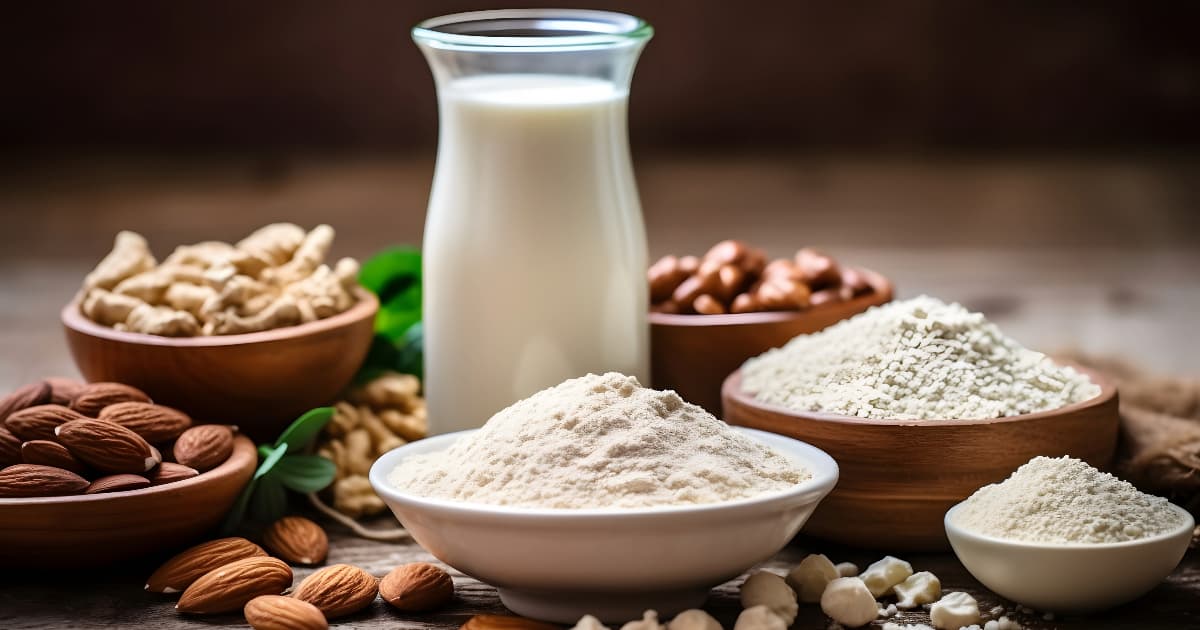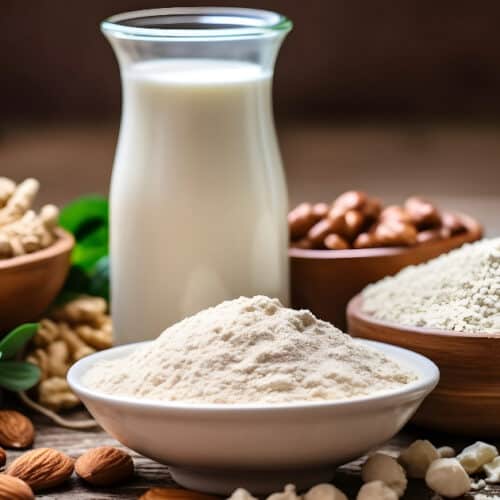Almond milk powder is a handy ingredient to have in your pantry. It can be used to quickly make nutritious and delicious almond milk at home. This powder is made by grinding almonds into a fine powder that can be easily mixed with water or milk to produce almond milk.

Making your own almond milk powder at home is very simple and allows you to control the ingredients. Many store-bought almond milk powders contain added sugars, thickeners and other unnecessary ingredients. By making it yourself, you can create a pure, additive-free almond milk powder.
Why Make Homemade Almond Milk Powder?
There are several benefits to making your own almond milk powder rather than buying it pre-made:
- Control ingredients: By making it at home, you can control exactly what goes into the powder. You can leave out added sugars, preservatives and other additives commonly found in commercial almond milk powders.
- Customize taste: You can customize the taste by adding ingredients like vanilla, dates, cinnamon or cocoa powder. This allows you to make flavors like vanilla, chocolate or spiced almond milk.
- Save money: Homemade almond milk powder is considerably cheaper than buying pre-made powders. Just a cup of almonds can make multiple batches of powder.
- Use blanched almonds: Most pre-made powders use almond meal, which contains the skins. Blanched almonds have the skins removed, producing a smoother and milder-tasting powder.
- No fillers or additives: Avoid unnecessary thickeners, emulsifiers, added sugars and preservatives commonly used in commercial almond milk powders to improve texture and shelf life.
So if you want complete control over the ingredients, make your own!
How to Make Almond Milk Powder
Making homemade almond milk powder takes just a few steps and ingredients:

Almond Milk Powder Recipe
Ingredients
- 1 cup raw almonds
- Water
- Pinch of salt (optional)
- Spices, sweeteners or other flavorings (optional)
Instructions
- Soak the almonds in water overnight, or boil for 1 minute then soak for 1 hour, to soften.
- Drain and rinse the almonds.
- Blanch the almonds by placing them in boiling water for 60 seconds then transferring to cold water. This helps loosen their skins.
- Peel off and discard the skins by pinching the almonds.
- Spread out the blanched almonds and allow to dry for a few hours.
- Roast the almonds at 300°F for 10-15 minutes until fragrant and slightly browned. This enhances the flavor and extends the powder's shelf life.
- Grind the roasted almonds into a fine powder using a food processor, blender or spice grinder. Grind in short bursts and stir to prevent overheating.
- Stir through any extra flavorings like vanilla, spices or sweeteners.
- Store the almond milk powder in an airtight container. Keeps for up to 8 weeks at room temperature or several months refrigerated or frozen.
Making Almond Milk from the Powder
Turning the DIY almond milk powder into drinkable milk only takes a minute.
For one serving of almond milk:
- Add 2-3 tablespoons of almond milk powder to a glass
- Whisk as you pour over 1 cup of cold or hot water, milk or non-dairy milk
- Stir well until uniform
- For added flavor, also stir in spices, vanilla or sweetener
The powder dissolves easily into water or milk to create a creamy, nutty-flavored almond milk perfect for drinking, pouring over cereal or using in smoothies or baking.
Pro Tips:
- Use hot water or milk and chill it after if you want it cold
- Go for unsweetened if using in savory dishes or smoothies with fruit
- Play around with flavors like cocoa powder or maple syrup
- For a frothy latte, blend with your milk and sweetener before heating
Compared to buying ready-made almond milk regularly, mixing up your own using DIY powder is very economical. And you'll always have an emergency supply handy!
So next time you run out of milk, don't run to the store - just grab your homemade almond milk powder. In less than 60 seconds you can be enjoying a chilled glass!
Can You Make Almond Milk Powder Without Blanching?
You can actually make almond milk powder without blanching the almonds first. However, blanching is highly recommended for the best flavor and texture.
Here's why blanching helps:
- Removes bitter skins - Raw almond skins contain tannins and enzyme inhibitors that can cause bitterness and effect digestion. Blanching helps remove most of these.
- Improves powder texture - Skins make the powder grainier. Removing them produces super fine powder that blends smoothly into milk or water.
- Boosts mildness - The darker skins impart a stronger flavor. Blanching gives you bright white nuts with a more delicate, subtle almond taste.
While not an essential step, taking the couple of minutes to scald then peel the skins means your homemade almond milk will taste sweeter and smoother.
If you do skip blanching, try adding a little extra sweetener to mask any bitterness from the skins. Vanilla extract also helps mellow the flavor.
Making Flavored Almond Milk Powder
One of the great things about DIY almond milk powder is it's easy to customize with extra flavors. Simply stir them in after grinding the almonds.
Delicious flavor options include:
- Vanilla - A classic pairing, add 1 tsp vanilla extract or 1 vanilla bean paste per 1 cup powder
- Cocoa - For chocolate milk, stir in 2-4 tablespoons cocoa powder
- Cinnamon - Lovely warming flavor, add 1 tsp ground cinnamon
- Cardamom - Also makes a delicious spiced Indian-style milk, add 1⁄2 tsp ground cardamom
- Dates - Chop and grind 4-5 pitted dates into the almonds for natural sweetness
- Maple - For sweetness, add 2-3 tablespoons maple syrup
- Honey - Another sweetener option, stir in 1-2 tbsps honey
- Lavender - Unique floral flavor, blend in 1⁄2 tsp dried culinary lavender
Be creative and make your custom almond milk flavors!
Tips for Making the Best Almond Milk Powder
Follow these helpful tips for top quality, great-tasting homemade almond milk powder:
- Use raw almonds - They produce the sweetest, most flavorful powder.
- Blanch thoroughly - This is vital for removing all the bitter skins and their tannins.
- Dry well before roasting - Reduces stickiness and helps achieve a super fine powder.
- Don't over-roast the almonds - just until fragrant and lightly browned to bring out their oils.
- Let nuts fully cool before grinding - prevents them turning oily.
- Grind in small batches - Less than a cup at a time for your machine to cope best.
- Stir during grinding - Prevents overheating which destroys nutrients and causes stickiness.
- Use airtight jars - Excludes moisture and air to keep your powder fresh for weeks.
- Store in the fridge - Keeps it fresher for longer.
Storing Your Homemade Almond Milk Powder
Like ground nuts and seeds, almond milk powder is perishable due to its oils going rancid over time. Follow these storage guidelines:
- 1-2 months shelf life unrefrigerated when stored in airtight containers
- Up to 8 weeks counter-top life if antioxidant spices like cinnamon are added
- 2-3 months refrigerated
- 6 months frozen
Glass jars, containers or freezer bags all work for storage. Ensure all air is pressed out and the container fully sealed.
Refrigerating or freezing gives your homemade powder the longest safe shelf life. Allow to come to room temperature before use.
Properly stored, your DIY almond milk powder will stay fresh for months, saving repeat trips to the store.
FAQs
Why does my powder turn oily and clumpy?
This happens if the almonds release too much oil, often from overheating them while grinding. Ensure nuts are fully cool before grinding. Use short grinding bursts then stir. Refrigerate the powder to harden oils.
What's the best milk for making almond milk?
You can use any milk - dairy milk, plant-based milk like soy or oat milk, coconut milk or just water. Using skim or low-fat milk gives a richer taste without excess fat.
Can I use almond meal instead of grinding whole nuts?
Yes, but the milk may have lingering bitterness if the almond skins aren't removed first. For sweetest tasting milk, use blanched almonds or almond flour.
How long does homemade almond milk last?
Around 4 days is best refrigerated, though up to a week is still safe. It lasts months frozen but may separate on thawing needing a good shake or blend.
What's the ratio of powder to water?
The average amount is 2-3 tablespoons (1-11⁄2 oz) powder whisked into 1 cup water or milk. Adjust to your preferred thickness and flavor strength.
Can I use other nuts like cashews or hazelnuts?
Yes, you can apply the same method to make your own cashew or hazelnut milk powders. Pistachios and walnuts also work well.
Conclusion
Homemade almond milk powder is incredibly quick and easy to whip up at home. With just raw almonds, water and a few key steps like soaking, blanching and roasting, you can create batches of additive-free powder for making nutritious milk anytime.
Compared to store-bought powders, you'll avoid unnecessary fillers like sugars, starches and gums by DIYing. And you can tailor the flavor exactly how you like it - try vanilla, chocolate or spiced.

